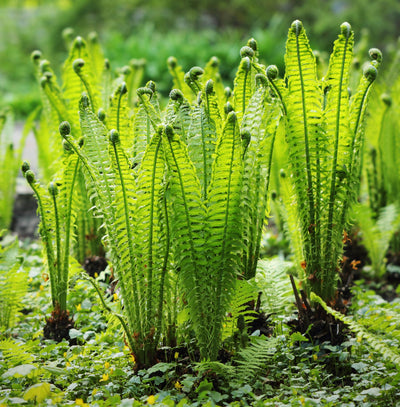
10 Wild Plants to Plant Indoors
Share
Indoor gardening offers a unique opportunity to cultivate the beauty of the wild within the comfort of your own home. While many gardeners focus on traditional houseplants, exploring the world of wild plants can bring a sense of adventure and connection to the natural world. From ferns and mosses to flowering herbs and foliage, these 10 wild plants can thrive indoors and infuse your living spaces with a touch of untamed charm.
1. Maidenhair Fern (Adiantum spp.)

Maidenhair ferns are renowned for their delicate, lacy foliage and their preference for filtered light. With their fronds resembling fine hairs, these ferns create an elegant and airy presence in indoor spaces. Provide them with consistent moisture and indirect light for optimal growth.
2. Snake Plant (Sansevieria spp.)
Also known as the "mother-in-law's tongue," snake plants are tough and adaptable. Their upright, sword-like leaves come in various patterns and colors. Snake plants thrive in low light conditions and require minimal watering, making them ideal for busy indoor gardeners.
3. Spider Plant (Chlorophytum comosum)
Spider plants are beloved for their arching, variegated leaves that resemble spider legs. These adaptable plants are excellent air purifiers and can thrive in a range of lighting conditions. Spiderettes, or small plantlets, can be propagated to create new plants.
4. Creeping Fig (Ficus pumila)
Creeping fig is a versatile vine that can be grown as a trailing plant or trained to climb along walls and trellises. Its small, heart-shaped leaves create a lush and verdant appearance. Keep the soil consistently moist and provide bright, indirect light for optimal growth.
5. English Ivy (Hedera helix)
English ivy is a classic choice for indoor gardening, known for its trailing vines and distinct, lobed leaves. It can be grown in hanging baskets or trained to climb. English ivy prefers bright, indirect light and slightly moist soil.
6. Mosses (Various Genera)
Mosses bring the enchantment of forests and woodlands indoors. They thrive in moist, shaded conditions, making them excellent choices for terrariums or decorative displays. Mosses add a touch of magic and tranquility to indoor spaces.
7. Oregano (Origanum spp.)
Herbs like oregano can be grown indoors to provide fresh flavor to your culinary creations. Oregano's aromatic leaves are ideal for cooking, and they thrive in a sunny windowsill. Regular pruning will encourage bushy growth and a steady supply of leaves.
8. African Violet (Saintpaulia spp.)
African violets are beloved for their charming, fuzzy leaves and delicate, colorful flowers. They prefer bright, indirect light and well-draining soil. With proper care and regular feeding, African violets can bloom throughout the year.
9. Scented Geranium (Pelargonium spp.)
Scented geraniums are prized for their fragrant leaves that release delightful aromas when touched or brushed against. Varieties include rose, lemon, mint, and more. These versatile plants thrive in sunny spots and can be grown indoors year-round.
10. Pilea (Pilea spp.)
Pilea, also known as the "Chinese money plant" or "pancake plant," features round, coin-like leaves on slender stems. Its unique appearance and ease of care have made it a popular choice among indoor gardeners. Pilea prefers bright, indirect light and regular watering.
Caring for Your Indoor Wild Plants
While each wild plant has its specific needs, there are general care guidelines that apply to many indoor species:
- 1. Light: Assess the lighting conditions in your home and choose plants that match those conditions. Most indoor wild plants thrive in bright, indirect light.
- 2. Watering: Pay attention to the moisture requirements of your plants. Allow the top inch of soil to dry out before watering again. Overwatering can lead to root rot.
- 3. Humidity: Some wild plants, such as ferns and mosses, appreciate higher humidity levels. You can enhance humidity by placing plants on trays filled with water or using a room humidifier.
- 4. Potting Mix: Use a well-draining potting mix suitable for indoor plants. Ensure that your containers have drainage holes to prevent waterlogged roots.
- 5. Pruning: Regularly prune dead or yellowing leaves to encourage healthy growth. Trimming also helps maintain the desired shape of your plants.
- 6. Fertilization: Indoor plants benefit from occasional fertilization during the growing season. Use a balanced, water-soluble fertilizer according to the manufacturer's instructions.
- 7. Pests and Diseases: Keep an eye out for pests like aphids and spider mites. Isolate new plants for a few weeks to prevent introducing pests to your existing collection.
The Joys of Indoor Wild Gardening
Cultivating wild plants indoors offers a range of benefits and joys:
- 1. Connection to Nature: Bringing the beauty of the wild indoors allows you to connect with nature regardless of your living environment.
- 2. Creativity: Designing unique arrangements and displays with wild plants lets you express your creativity and create personalized indoor landscapes.
- 3. Stress Relief: Caring for indoor plants has been shown to reduce stress, boost mood, and improve overall well-being.
- 4. Learning Opportunity: Growing a variety of indoor wild plants exposes you to different care requirements, helping you develop your gardening skills.
- 5. Aesthetic Appeal: The diverse textures, shapes, and colors of indoor wild plants add a touch of elegance and natural beauty to your home.
Conclusion
Introducing wild plants into your indoor spaces invites the untamed spirit of nature to thrive alongside you. From trailing vines to delicate ferns, each plant offers its unique charm and personality. As you care for these indoor companions, you'll not only create a tranquil and vibrant environment but also deepen your connection to the wild world beyond your windows. Indoor wild gardening is a journey of discovery, nurturing, and sharing in the wonders of nature, all within the cozy confines of your home.








